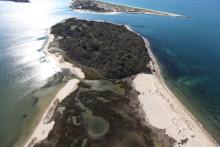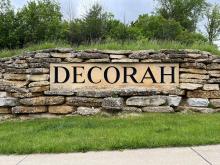
The streaks of paint and tiny white flags popping up across Block Island are not signs of surrender. They are signs of progress. The popular summer tourist destination, nine miles off the coast of Rhode Island, is on the verge of building a Fiber-to-the-Home (FTTH) network, bringing gig-speed Internet connectivity to the more than 1,000 residents who call the community home.
The markers on residents’ property are plot points along the construction route as network planners prepare to start building the last-mile portion at the end of March.
On Feb. 4, BroadbandBI launched its website, announcing that the construction materials had finally arrived on the Island and signaling the start of construction would soon be underway.
Sertex, the company partnering with the town to build the network, is anticipating deploying more than 60 miles of fiber to deliver high-speed Internet service directly to homes and businesses in New Shoreham, the only town on Block Island.
Pop the Champagne
Residents there unanimously voted in July 2020 to pay for the construction of the island-wide network with $8 million in bonds. Approval for the project was so overwhelming that when the vote took place the Block Island School gymnasium erupted with cheers and applause.
Currently, there are still only three options for Internet service on the Island: Verizon DSL, satellite, and mobile services with the fastest speed advertised at 35 Megabits per second (Mbps). And for a period of time, it seemed as if residents were doomed to those tortoise-like speeds forever.
In 2014, the Block Island Times captured experiences from its readers after an especially frustrating summer of spotty service. One reader, Jessica Fischburg wrote, “We have Verizon and live down in Franklin Swamp. No cell service. Our Internet is painfully slow unless you wake up super early. We have no choice but to disconnect when we come out to the island!”
The Answer Was Blowing in the Wind
But in 2016, a glimmer of hope came in the form of the first commercial offshore wind farm in the United States. Because of the Block Island Wind Farm, a direct fiber optic line into the nation’s power grid was installed underwater. By 2019 the island had its own middle-mile infrastructure in place in the form of the Community Anchor Institutions (CAI) Fiber Optic Network, making it the first municipally-owned fiber optic network in the state of Rhode Island.
With the eight strands of fiber making their way to the island, the town of New Shoreham turned to Sertex to build the network as the company has done in dozens of communities in the northeast.
The first island facilities connected to the CAI network were the medical center, school, public library, public safety complex, and town hall. That laid the foundation for the fiber network to be extended across the island.

With the launch of the BroadbandBI website in February residents across the island were encouraged by the Broadband Committee to register for service via the new website. To date, approximately 50 percent of island households registered for a drop, according to Michael Solitro, Sertex founder and CEO.
“All properties on the Island will receive a drop. There are approximately 1,650 existing developed properties that will be connected with fiber drops. Sertex will also be making provisions for future development on about 150 undeveloped sites,” Solitro said.
Once residents register, they are added to the “fiberhood” map of all the neighborhoods that will have access to the network. Starting this month, Sertex engineers are scheduling appointments with property owners for on-site consultations to assess the fiber deployment requirements for each household.
Sertex told the Block Island Times: “Coordination is required with property owners before any construction can begin in order to secure permissions for access and authorization of the drop route.”
Deployment in Waves
The drops will happen in geographical waves, and will mostly be underground. Meanwhile, the company is also working with a professional wetland scientist to secure permits and clear properties for construction with the Rhode Island Department of Environment Management and the Coastal Resource Management Council.
“The network will offer multiple tiers of service and allow room to expand in the future as individual and community needs evolve,” according to the BroadbandBI FAQ page.
Internet speed tiers will go up to 1 Gigabits per second (Gbps) symmetrical with no data usage caps. And while pricing for the different service packages has yet to be set in stone, in July 2020 the New Shoreham Broadband Committee released preliminary pricing to give residents and businesses an idea of what they can expect to pay for service when the network is live.
Subscribers will have an option of signing up for month-to-month service, 1-year, or 2-year contracts. The month-to-month option allows island residents to turn off their service when they leave the island, which they often do during the winter months. This is also why the Broadband Committee made maintenance and operation a separate fee, instead of including it in the tier prices as many other ISPs group them.
Residential service packages (including the maintenance and operation fee of $32) are projected to start at $57 per month for a 25 Megabits per second (Mbps) symmetrical connection; $62 per month for 50 Mbps symmetrical; $72 per month for 100 Mbps symmetrical; and $82 per month for 1 Gbps/100 Mbps.
Business prices and tiers for the month-to-month and 1-year contract options are projected to be $172 for 100 Mbps symmetrical and $1,032 for 1 Gbps symmetrical. The 2-year contract will reduce those prices to $132 for 100 Mbps symmetrical and $832 for 1 Gbps symmetrical.
Installation fees will be waived for residents who subscribe now, while residents who sign up for service after the build will have to pay for installation themselves.
Crocker Communications, a family-owned telecommunications company, will operate as the Internet Service Provider (ISP). Crocker previously worked with Leverett, Massachusetts, in establishing that citywide municipal fiber network.
Solitro said that once the Block Island network is live, they are expecting a whopping 95 percent take rate.
“This was an unserved area. I expect Block Island to follow the trend of Western Massachusetts towns that also had no service before we built their networks,” Solitro said.
Note: Additional explanation added above to clarify the included maintenance and operation fees.
Read Sertex CEO and Founder Michael Solitro talk more about the Block Island project here.
Header image by by U. S. Fish and Wildlife Service used via Creative Commons CC PDM 1.0








